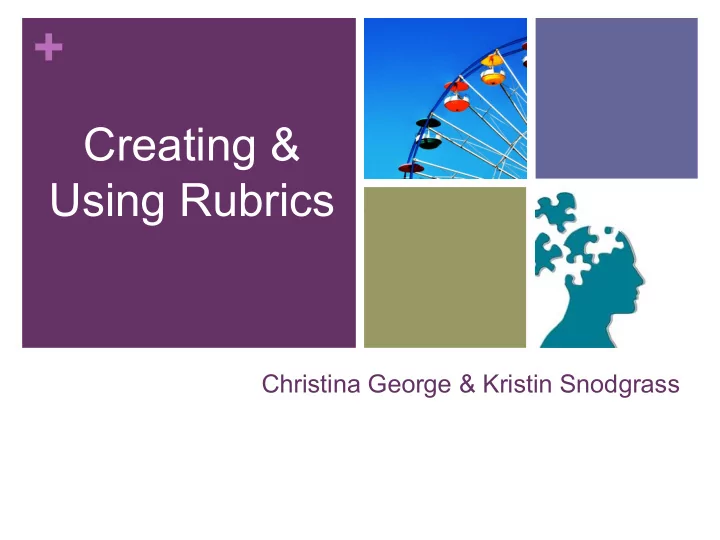

+ Creating & Using Rubrics Christina George & Kristin Snodgrass
+ Learning Objectives Understand when and Differentiate types of rubrics & determine why to use rubrics what works best for you Know how to use Create a rubric rubrics (or at least start brainstorming)
+ Rubrics: When and why? ■ When? ■ General assignments ■ Group work ■ Service learning ■ Major projects ■ Papers ■ Presentations ■ Online learning ■ Clinical case studies
+ Rubrics: When and why? ■ Why? ■ Decrease grading time ■ Provide fuller feedback ■ Transparency in expectations and intentions ■ Recognize teaching blind spots ■ Track student progress ■ Encourage self-assessment ■ Equity ■ Efficiently examine complex behaviors ■ Teach across the curriculum
+ Rubrics and Learning Goals ■ Integrate learning goals across venues and levels Macro ← → Micro • ■ The importance of measurable objectives Bloom’s Taxonomy • ■ Assessing the more difficult ■ Attitudes ■ Values ■ Dispositions Often program specific •
+ Types of Rubrics Analytic Holistic Allows for leeway and Allows for identification of ■ ■ flexibility specific criteria or level of Allows for an ‘overall’ score to achievement to be addressed ■ be given based on a majority in each cell. of the evidence. Each identified component is ■ Allows for multiple essential to the performance ■ components to be assessed in or product. the product. Ratings or scores are given ■ Must still address each based on the successful ■ component at each level completion of each discrete, despite use of criterion single cell. groups. Each strand or criteria is met ■ To ensure all components of a with a specified leveling of ■ holistic rubric are considered, achievement. is to convert to an analytic Best used for individual work ■ rubric. or for pieces of a group Best used for performances, project. ■ artifacts or group work.
+ Types of Rubric Criteria Simple Additive Sequential Additive ■ Additive criteria assess overall ■ Sequential, additive skill by specifying increasing strands are accumulated skill level to be observed. in a specific sequence or ■ Design a simple additive rubric order. by starting at the highest level ■ Design this criteria by of competence expected. starting at the lowest level ■ Faculty work includes listing all of competence. aspects of the skill that must ■ This rubric criteria allows be done to achieve that level of for the components of the competence being measured. overall skill to be added as ■ The emphasis is on the the student progresses accumulation of skill across the rubric. components relative to a program, plan of study or other successful outcome.
+ Types of Rubric Criteria Developmental Other Criteria Options ■ Developmental ■ Descriptive criteria is used to ■ Quality Enhanced demonstrate growth ■ Quantity Structured or proficiency. ■ Alignment Based ■ Design this criteria by working on the minimal skill level to the higher skill levels ■ Skills are expanded as the student moves across the strand.
+ Four Parts to Every Rubric 2. Criteria to be rated (rows). Also 1. Task description known as dimensions. 3. Levels of 4. Descriptions of each criteria at each achievement level of achievement (columns). (cells).
+ Creating Rubrics: Key stages 1. Reflecting What do I want from students? ▪ Why did I create this assignment? ▪ How does this assignment relate to the rest of the class content? ▪ What skills do students need to complete the assignment? ▪ How will students demonstrate their learning? ▪ What’s the highest/lowest performance expectation? ▪ 2. Listing Which specific learning objectives do you hope to see in the ■ completed assignment? What are your baseline criteria? ■ What are some objectives you might list for an assignment in your own course?
+ Creating Rubrics: Key stages 3. Grouping and labeling From stages 1 and 2, group related highest performance ■ expectations. Construct groups of similar performance expectations: ■ Allow this to be a back and forth process. ■ Label the group (these will ultimately become the rubric dimensions). ■ Organization, context, analysis, presentation, etc. • 4. Application Apply the dimensions developed in stage 3 to the final form of rubric. ■
Creating & Using Rubrics in Blackboard
+ Converting Rubric Scores into Grades: 3 Scenarios 1. Convert rubric score point totals on individual assignments to a percentage or letter grade for the assignment. 2. Convert rubric score totals on major assignments to a letter grade for the course. 3. Combine rubric scores and other forms of scoring, such as percentages to a letter grade for an entire course.
+ Using Rubrics *Tips ■ Find and adapt an existing rubric. ■ Constantly evaluate. ■ Collect samples of student work that exemplify each point on the level. ■ Share good rubrics with colleagues and ask for feedback. ■ Use student friendly language. ■ Share the rubric with your students. ■ Be succinct. ■ Align rubric with assignment sheet and vice versa. ■ Leave constructive comments in addition to using the rubric. ■ Avoid being punitive.
+ Helpful Sources ■ Dynnesson, T. L., Gross, R. E., & Berson, M. J. (2002). Designing effective instruction for secondary social studies (3 rd ed.). Upper Saddle River, NJ. Prentice Hall. ■ Goggins Selke, M. J. (2013). Rubric assessment goes to college: objective, comprehensive evaluation of student work. Lanham, MD: R&L Education. ■ Stevens, D. D., & Levi, A. J. (2013). Introduction to rubrics: an assessment tool to save grading time, convey effective feedback, and promote student learning (2 nd ed.). Sterling, VA: Stylus. ■ Suskie, L. (2009). Assessing student learning: a common sense guide (2 nd ed). San Francisco, CA: Jossey-Bass. ■ Wlodkowski, R. J. (2008). Enhancing adult motivation to learn: a comprehensive guide for teaching all adults. (3 rd ed). San Francisco, CA: Jossey-Bass.
+ Time to work! Q&A
Recommend
More recommend